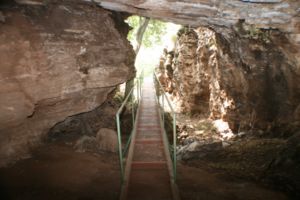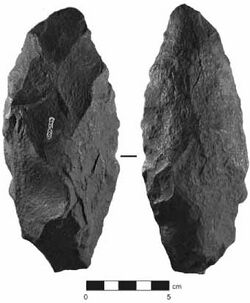Gladysvale Cave: Difference between revisions
imported>Caesar Schinas m (Bot: Update image code) |
imported>Meg Taylor m (spelling: approximatly -> approximately) |
||
| Line 24: | Line 24: | ||
==Archeological remains== | ==Archeological remains== | ||
{{Image|GV handaxe.jpg|right|250px|A handaxe from the Gladysvale cave, South Africa. The tool is dated to | {{Image|GV handaxe.jpg|right|250px|A handaxe from the Gladysvale cave, South Africa. The tool is dated to approximately 800,000 years. }} | ||
Tools have also been found with the most spectacular being an [[Acheulean handaxe]], recovered from 1 million year old sediments<ref name="Hall"/>. Iron Age artefacts and remains are found in overlying sediments of the internal deposits. | Tools have also been found with the most spectacular being an [[Acheulean handaxe]], recovered from 1 million year old sediments<ref name="Hall"/>. Iron Age artefacts and remains are found in overlying sediments of the internal deposits. | ||
Revision as of 22:39, 5 February 2010
Gladysvale Cave (25 54'S, 27 45'E) is a fossil-bearing breccia-filled cave located about 13km Northeast of the well known South African hominid-bearing sites of Sterkfontein and Swartkrans and about 45km North-Northwest of the City of Johannesburg, South Africa. It is situated within the Cradle of Humankind World Heritage Site.
History of investigations
Gladysvale is the first cave that Robert Broom visited in the Transvaal in his mid-1930's search for a hominid-bearing cave nearer to Johannesburg than Taung[1]. He visited Gladysvale after a butterfly collector from the Transvaal Museum reported a "human mandible" in the wall of the cave. When Broom arrived at the cave the mandible was gone. Sterkfontein soon lured Broom away from the site. In 1946 Phillip Tobias led a student expedition to the site where a fine baboon fossil was recovered[2]. In 1948 Frank Peabody of the Camp-Peabody expedition from the United States spent several weeks at Gladysvale but failed ot find any hominid remains. The site was lost from scientific memory until it was re-opened by Lee Berger and Andre Keyser in 1991. Within a few week of excavation the first hominid remains were discovered - two teeth of Australopithecus africanus. This discovery made Gladysvale the first new early hominid site to be discovered in South Africa since 1948 (when the last site - Swartkrans - was discovered by Robert Broom)[1].
Since the discovery of these teeth more than a quarter of a million fossils have been recovered from Gladysvale during excavations conducted by joint teams from the University of the Witwatersrand, the University of Zurich and Duke University[3].
Geology
Gladysvale is a large system of caves consisting of several underground chambers reaching to a depth of 65 m below the surface.The presently roofed section consists of an upper chamber and at least two lower depositories, in which a number of different aged fills are preserved. These are collectively known as the Gladysvale Internal Deposits (GVID). The outer de-roofed section is known as the Gladysvale External Deposit (GVED)[4].
Age of the deposits
The Gladysvale sequence has been dated using faunal methods and absolute methods. At present, the youngest deposits are thought to be around 54,000 years old while the oldest are around 2 million years old. To date at least five episodes of cave fill have been documented, which, based on the fauna and provisional ESR dates seem to have occurred from around 2 Mya, with clusters of dates at 1.4-1.2 Mya, 800-600 kyr, and 250-200 kyr[4].
Gladysvale has become well known for its exceptional horizontally-bedded stratigraphy and has been the site of the testing of many of the absolute dating techniques which have proved successful on the hard to date breccias of the South African fossil-bearing caves. The site is presently divided into three underground cave systems with the upper cave holding the Gladysvale Internal Deposits and an External Deposit. Gladysvale was one of the first sites in Africa to be 3-D digitally mapped by Peter Schmid and students from the University of Zurich [3].
Recovered fossils
Many thousands of fossils have been recovered from the Gladysvale deposits including rare remains of hominids. From the Gladysvale external deposits (also called the GVED), almost a quarter of a million bones have been recovered since excavations began in 1992. There are many hundreds of bones still in place in the cave. Fossils recovered include antelope, giant zebra, carnivores including extinct wolves, monkeys and hominids attributed to Australopithecus africanus and early ''Homo''[3].
Archeological remains
Tools have also been found with the most spectacular being an Acheulean handaxe, recovered from 1 million year old sediments[4]. Iron Age artefacts and remains are found in overlying sediments of the internal deposits.
Fossil species recovered
Gladysvale External Deposits (GVED) Species List[5].
Order Primates
Family Hominidae
- Homo sp.
Family Cercopithecidae
- Papio indet.
Order Carnivora
Family Felidae
- Panthera leo
Family Hyaenidae
- Hyaenid indet.
Family Canidae
- Canis mesomelas
Order Artiodactyla
Family Bovidae
- Tragelaphus strepsiceros
- Taurotragus oryx
- Pelorovis sp.
- Syncerus sp.
- Kobus leche
- Redunca arundinum
- Redunca fulvorufula
- Hippotragus mutinies
- Hippotragus niger
- cf. Oryx gazella
- Megalotragus sp.
- Connochaetes taurinus
- Connochaetes sp. indet.
- Damaliscus dorcas
- cf. Aepyceros sp.
- Raphicerus campestris
- Oreotragus oreotragus
- Antidorcas bondi
- Makapania sp.
Family Suidae
- Phacochoerus sp.
Family Giraffidae
Order Perissodactyla
Family Equidae
- Equus capensis
- Equus burchelli
Order Hyracoidea
- Procavia capensis
- Procavia transvaalensis
Order Rodentia
- Hystrix africaeaustralis
References
- ↑ 1.0 1.1 Berger et al. (1992a). Gladysvale - first early hominid site discovered in S. Africa since 1948. Am. J. Phys. Anthrop..
- ↑ Berger et al. (1992b). Gladysvale Unveiled. S. Afr. J. Sci..
- ↑ 3.0 3.1 3.2 Hilton Barber, B. and Berger, L.R. (2001). Field Guide to the Cradle of Humankind. Struik.
- ↑ 4.0 4.1 4.2 Hall et al. (2006). An Achuelean handaxe from the Gladysvale Cave Site in the Witwatersrand region of South Africa. S. Afr. J. Sci..
- ↑ R. S. Lacruz, J. S. Brink, P. J. Hancox, A. R. Skinner, A. Herries, P. Schmid and L. R. Berger (2002). Gladysvale PALAEONTOLOGY AND GEOLOGICAL CONTEXT OF A MIDDLE PLEISTOCENE FAUNAL ASSEMBLAGE FROM THE GLADYSVALE CAVE, SOUTH AFRICA.. Palaeont. Afr..



